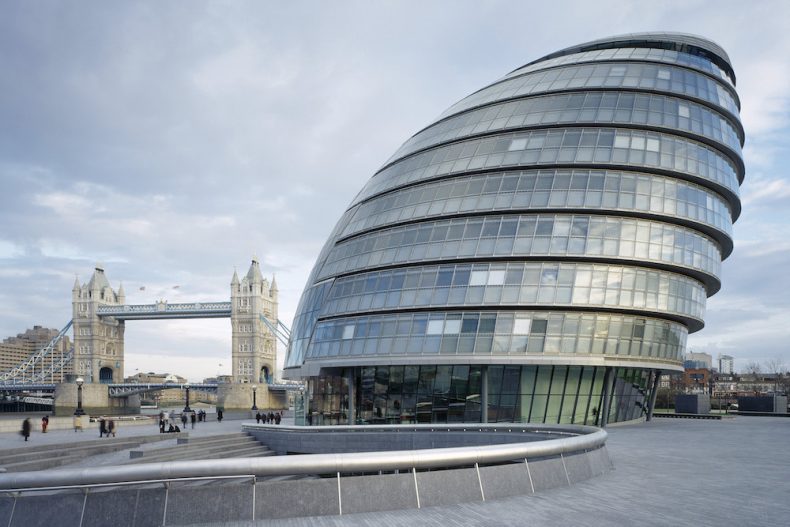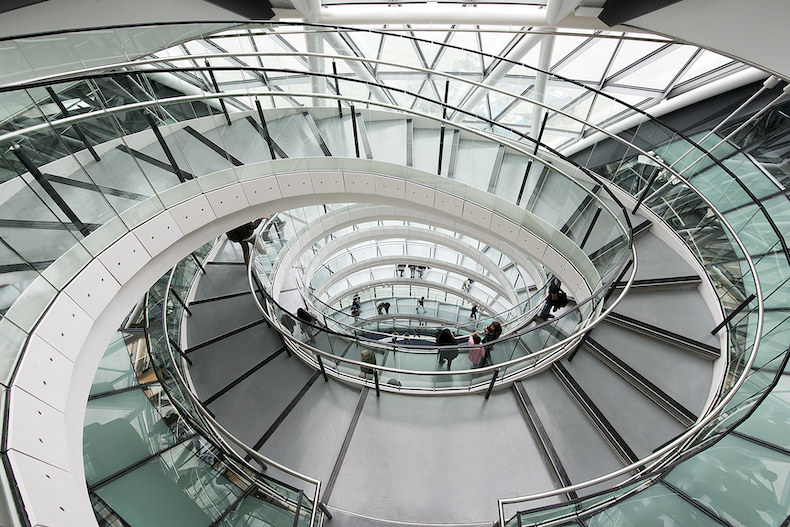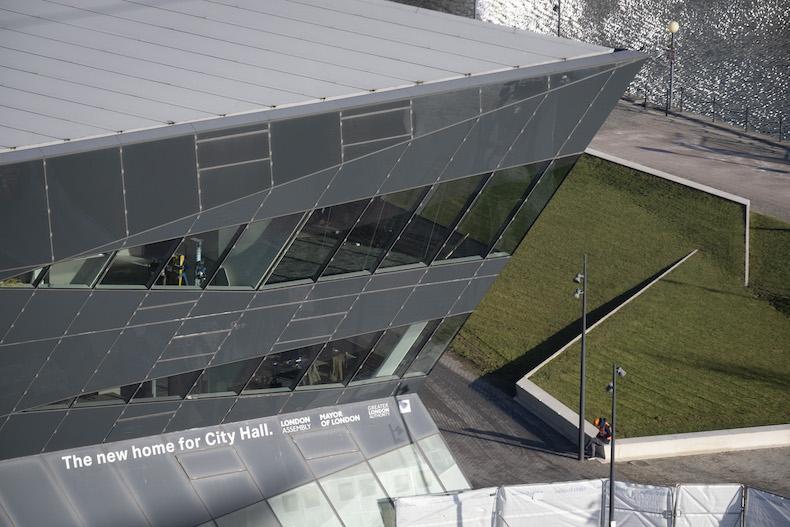In the early 1980s, the Greater London Council (GLC) and its leader Ken Livingstone used to hang a huge banner showing the number of London’s unemployed on the curving frontage of its Edwardian baroque home, County Hall. It faced the Palace of Westminster directly, was updated every month and infuriated Margaret Thatcher. In 1986, her Conservative government abolished the GLC, leaving London as probably the only great metropolis in the world without a citywide authority.
It would be left to a later Labour government to restore some kind of London-wide government and, in 2000, it created the post of mayor. County Hall had been sold off in 1992, so the mayor needed a new office, and a new building was commissioned: the more American-sounding City Hall, sited on an old dock also on the south bank of the Thames (but in Southwark rather than Waterloo). Its architect was Norman Foster, then still flying high on the wings of the German fat eagle, the non-threatening logo he designed for the new Reichstag building in Berlin.
City Hall, formerly the home of the London Mayor and the Greater London Authority, designed by Norman Foster. Photo: Getty Images

Historic England has just refused to grant City Hall listed status for a second time. The Greater London Authority and the London mayor moved out at the end of 2020 after the building’s Kuwaiti-owned landlords put up the rent. They are now in The Crystal, a building designed for Siemens as a kind of high-tech showroom at the Royal Docks near the Olympics site. The decision highlights the issue of symbolism in architecture, what a building means and how that is affected by its use. As the mayor’s office Foster’s City Hall had heft. As a gutted hulk repurposed for a mixed-use office and sandwich mall, it has none.
It was Livingstone, as the first holder of the new post of mayor, who likened City Hall to a ‘glass testicle’. Since then Foster’s building has undergone a vasectomy. The spiral ramp, a weak echo of the spiral in the Reichstag’s glass dome which allowed citizens to enter the building and look down on their representatives, was stripped out in an effort to make the building more suitable for offices and retail. Security concerns meant that the building was almost never as publicly accessible as originally intended – it was not Foster’s greatest building anyway. Travel a little further upstream and you can find his own office and penthouse in Battersea, a beautiful work of late modernism which blows City Hall’s wonky helmet out of the water.
Capitols The spiral ramp inside Norman Foster’s London City Hall, formerly the headquarters of the London Mayor and Greater London Authority, has now been stripped out. Photo: Getty Images

It does, however, leave us with the issue of the original County Hall, which is listed at Grade II* but has been allowed to foster (forgive the word) an ecosystem of the worst tourist tat imaginable. The once dignified, if rather cold, building is now a site Londoners go out of their way to avoid, like Leicester Square.
The Edwardian building was the result of a competition launched in 1906, which was won by a 29-year-old architect named Ralph Knott. He was a virtual unknown who had not built much at all, although he had worked on the designs for the Victoria and Albert Museum during his time in the office of Aston Webb. It is, frankly, no masterpiece, but it stems from an era when Britain was at the height of its imperial power and London was the wealthiest and most populous city in the world. Its local government – the London County Council (LCC) – was a pioneer of social housing, building huge suburban estates and inner city blocks. (It was replaced by the GLC, which covered a greater area, in 1965.) In its mission to improve, educate and house the people, the LCC did not want to appear too extravagant, so this austere and rather joyless – though also enormous – mass of stone with giant order arches bookending the elevations and an odd little copper-clad spire did the job just fine. Construction started in 1911 and the building opened in 1922, a long decade, interrupted by the First World War, in which Britain’s architecture of default was a grand imperial classicism (the ‘Wrenaissance’). Its near contemporaries are the rebuilt Regent Street, the new Kingsway and Bush House, the Port of London Authority HQ, Trinity House (now a hotel) and the vast cliff of Freemasons’ Hall.
The Palace of Westminster and County Hall are both glorified office blocks, but only County Hall acknowledges that fact. The buildings work well as a pair: the self-conscious kitsch of Parliament facing off against the administrative no-nonsense style of the old LCC. There is a sense in which the current state of County Hall perfectly represents the worst excesses of privatisation: a huge piece of public infrastructure repurposed as an incoherent mass of hotel, aquarium, the London Dungeon and ‘Shrek’s Adventure!’
Aerial view from the Emirates Air Line cable car, the London Assembly’s new City Hall at The Crystal at Royal Victoria Dock. Photo: Richard Baker/In Pictures via Getty Images

The transfer of County Hall to the private sector has also degraded an entire stretch of public waterfront. The London Eye was meant to be a temporary fixture, but by sticking around it has spurred the stupidification of central London. A pseudo-fairground aesthetic continues to plague the capital in the form of viewing platforms, city experiences and overpriced sky gardens. (We have, however, been spared Norman Foster’s ‘Tulip’, a cotton-bud-shaped private party tower for the city, which was a platform too far for planners). The trend for ‘experiences’ fundamentally misunderstands both the nature of a city and the nature of a fairground: the latter is exciting mainly because it here today and, hopefully, gone tomorrow.
There’s not much to regret in Foster’s City Hall being rejected for listing, but a great deal in the loss of London’s administrative heart. Meanwhile the mayor and the Greater London Authority are left to wander the city, moving from one ill-suited glass bauble to another. The solution, surely, would be to issue a compulsory purchase order for County Hall and return it to London for its government, its use and its dignity.
The debating chamber at County Hall in 2013. Photo: Peter Dazeley/Getty Images

Edwin Heathcote is the architecture and design critic of the Financial Times. His most recent book, On the Street: In-Between Architecture, is published by HENI Books.



